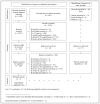School Reintegration Following Psychiatric Hospitalization: A Review of Available Transition Programs
- PMID: 35614957
- PMCID: PMC9084372
School Reintegration Following Psychiatric Hospitalization: A Review of Available Transition Programs
Abstract
Objectives: This study aimed to 1) identify transition programs for school reintegration after youth psychiatric hospitalization, and 2) assess these programs using criteria established by Blueprints for Healthy Youth Development.
Method: Principles outlined by the Evidence for Policy and Practice Information and Coordinating Centre were used to systematically search 15 electronic databases up to October 2021 for both published and unpublished reports of transition programs. Reports meeting inclusion criteria were examined through three steps: 1) coding of available information, 2) synthesis of programs and 3) assessment of intervention specificity.
Results: Thirteen reports met the inclusion criteria and identified eight transition programs. Program theories were rarely explicit about the causal mechanisms and outcomes of their interventions. Nevertheless, areas of consensus emerge as to core components of these programs including: 1) the involvement of a multidisciplinary team, 2) the implementation of a multicomponent intervention, 3) the development of a reintegration plan, 4) the need for gradual transitions, and 5) extended support through frequent contact.
Conclusion: School reintegration programs following psychiatric hospitalization are still rare. They can be hard to implement due to the challenges they impose for inter-professional and intersectoral collaborations. Despite this, four of the eight programs are in a good position for an evaluation of their promising standing. Nevertheless, well-designed controlled trials and cohort studies are needed.
Objectifs: Cette étude visait à 1) identifier des programmes de transition ayant pour but de favoriser la réintégration scolaire des jeunes à la suite d’une hospitalisation psychiatrique et 2) évaluer ces programmes sur la base de critères établis par les experts du Blueprints for Healthy Youth Development.
Méthode: Les principes énoncés par le Evidence for Policy and Practice Information and Coordinating Centre (EPPI-Centre) ont été suivis pour conduire une requête systématique dans 15 banques de données informatisées, en date du mois d’octobre 2021, à la recherche de documents publiés et non publiés portant sur des programmes de transition. Les documents qui rencontraient les critères d’inclusion ont fait l’objet d’un examen en trois étapes: 1) codification de l’information disponible, 2) synthèse des programmes et 3) évaluation des programmes au regard du critère de spécificité de l’intervention.
Résultats: Treize documents ont rencontré les critères d’inclusion et ont permis d’identifier huit programmes de transition. Les théories de ces programmes sont rarement explicites au sujet de leurs mécanismes causaux et des changements anticipés des interventions qu’ils préconisent. Néanmoins, un consensus se dégage au sujet des composantes clés de ces programmes: 1) l’implication d’une équipe multidisciplinaire, 2) l’implantation d’une intervention multimodale, 3) le développement d’un plan de réintégration, 4) l’importance d’effectuer les transitions de manière progressive, et 5) l’offre de soutien prolongé au moyen de contacts fréquents.
Conclusion: À ce jour, les programmes de réintégration scolaire à la suite d’une hospitalisation psychiatrique se font rares. Ils peuvent être difficiles à implanter en raison des défis qu’ils posent sur le plan de la collaboration interprofessionnelle et intersectorielle. Malgré cela, quatre des huit programmes identifiés sont en bonne position pour une évaluation de leur caractère prometteur. À cet effet, le recours à des devis de recherche rigoureux, comme des protocoles expérimentaux et des études de cohorte, s’avère nécessaire.
Keywords: hospitalisation psychiatrique; pratiques de transition; programmes de réintégration scolaire; psychiatric hospitalization; santé mentale des jeunes; school reintegration programs; transition practices; youth mental health.
Copyright © 2022 Canadian Academy of Child and Adolescent Psychiatry.
Conflict of interest statement
Conflicts of Interest: This study was funded by the Social Science and Humanities Research Council (SSRHC), Insight Development Grant #430-2014 01036. The authors have no conflict of interest to disclose.
Figures
References
-
- Anthony WA. Recovery from mental illness: The guiding vision of the mental health service system in the 1990’s. Psychoso Rehab J. 1993;16(4):11–23. doi: 10.1037/h0095655. - DOI
-
- Kagabo R, Kim J, Hashibe M, Kleinschmit K, Clark C. Predictors of hospital readmission for children with psychiatric illness who have received an initial course of treatment. J Psychiatry Ment Health. 2016;1(2):1–7. doi: 10.16966/2474-7769.109. - DOI
LinkOut - more resources
Full Text Sources
Miscellaneous

